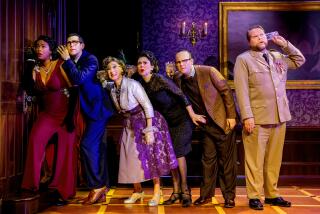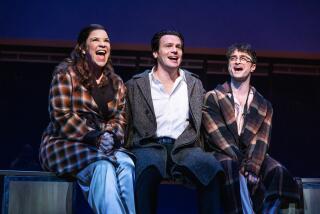Critic’s Notebook: A banner year for Broadway, but …
Broadway has had a good year by most accounts. Box-office receipts have just been tallied, and it turns out that this has been the highest grossing season on record. Attendance is up, and artistic moods have justifiably brightened. A broad spectrum of drama, old and new (some of it genuinely challenging), has helped counterbalance the commercial froth. And “The Book of Mormon,” which has the Tony for best musical in the bag, has given New York its first runaway hit in some time that actually received stellar reviews.
What kind of contrarian am I to complain? A contrarian, I guess, who’s trying to sort out a hodgepodge season that, no matter how you spin it, reveals that Broadway is still in the throes of its 21st century identity crisis.
The best news is that producers, audiences, artists and critics haven’t thrown in the towel, surrendering to the theme-park takeover of Times Square. Broadway hasn’t become that tourist-only zone so many of us feared, and by “tourist” I’m not referring to non-NYC ZIP Codes but to a “Gone Fishing” mentality that seeks frivolous escape with a Hollywood star, a pop music catalog, a borrowed movie title or some combination of all three.
But there’s something unsettled about the lowbrow-middlebrow-upper-middlebrow mix that’s been attempted this year. Shows that I would never have expected to see on Broadway (“Bloody Bloody Andrew Jackson,” “The Scottsboro Boys,” “Bengal Tiger at the Baghdad Zoo”) found themselves competing for theatergoers in a Darwinian jungle that has for the last decade of multimillion-dollar spectacles encouraged the survival of the fattest.
There’s no reason that the reign of bullying blockbusters shouldn’t be challenged, but the gap between commercial viability and cultural esteem is only widening. The strain is nowhere more evident than with critics, who seem to be advocating more than evaluating of late — that is, when they’re not second-guessing their own instincts.
Everyone has been touting this as a banner year on Broadway for new drama, but the favorite to win the Tony for best play is still an English import, “War Horse,” even though the script is the weakest element of this visually enthralling puppetry experience. “Jerusalem,” the other British play in contention, is memorable mainly for the commanding, relentless, outsize performance of Mark Rylance as a drug-peddling Falstaff living in a trailer on campgrounds that are like a suburbanized Forest of Arden.
These works rolled into New York as preordained award winners, though they’re not necessarily the best plays on Broadway this season. My Tony vote would be for Stephen Adly Guirgis’ “The Mother… With the Hat,” a work that might not be as ambitious as its transatlantic rivals but that has a caustic poetry of remarkable originality, curve-ball supporting characters and an audience-grabbing vitality focused on the emotional stakes of the protagonist (Bobby Cannavale), a recovering addict with a jealous temper that turbo-charges the plot. But in good theatrical times and bad, our subservience to the English stage is the one constant.
Some might chalk it up to Anglophilia, but this is no “Masterpiece Classic” phenomenon. London simply affords playwrights unparalleled opportunities to develop their craft in front of large audiences; consequently, dramatists there tend to write for crowds, not coteries.
Our nonprofit theaters were intended to serve as a substitute for Britain’s state-funded model, and the system, though faltering, occasionally comes through. “Good People,” David Lindsay-Abaire’s Tony-nominated drama, which was produced by Manhattan Theatre Club at the Samuel J. Friedman Theatre, has been widely hailed as a homegrown success. The play, which explores the subjects of class and race between former high school sweethearts from South Boston, strikes me as rather conventional in its plodding, realistic style. But the work gains in interest as Frances McDormand, playing a middle-age down-and-out “Southie,” barges into the affluent home of an ex-boyfriend (Tate Donovan), who’s now a successful physician married to a well-educated, socially poised African American woman (Reneé Elise Goldsberry), who looks on this intruder from her husband’s disadvantaged past with compassion.
“Good People” has a four-square construction and a message that’s subtle but not too subtle. It’s an exemplary institutional theater play that’s tailor-made to appeal to a cross-section of intelligent theatergoers. But such work runs the risk of seeming retrograde. Familiarity of form breeds familiarity of content. Lindsay-Abaire may have developed into a more assured writer since his early days as a purveyor of eccentric farces (“Fuddy Meers,” “Kimberly Akimbo”), but he’s traded his idiosyncratic adventurousness for mainstream acceptance (a strategy that earned him a Pulitzer for “Rabbit Hole”).
Who can blame him? The situation for a contemporary American playwright is confounding. Broadway is still more inclined to back a battle-tested Brit than a trailblazing Yank with growing clout. And far too many of our nonprofit theaters are relying on the commercial theater to supply their repertory. (Of course, the commercial and nonprofit worlds have become so incestuous that it’s almost silly to talk about them as discrete entities.)
Bright spots exist. Chicago, a hardcore theater town with avid audiences and prominent venues that invest in artists over the long haul, has been cultivating a bumper crop of prime-time-ready playwrights. Tracy Letts, who started out writing floridly violent plays of peculiar psychological fascination, has developed into one of the most successful Broadway playwrights around, thanks in large part to the support of Steppenwolf Theatre Company, without which “August: Osage County” (and less spectacularly “Superior Donuts”) might never have come into existence. Bruce Norris, who won the Pulitzer this year for “Clybourne Park,” has also benefited from Chicago’s theatrical richness.
Guirgis’ long and fruitful association with the LAByrinth Theater Company is another heartening sign. But if today’s most daring dramatists — Christopher Shinn, Annie Baker, Will Eno, Young Jean Lee — are entertaining Broadway dreams (an almost laughable thought), they’re sure not getting much of a helping institutional hand. A case can indeed be made that Shinn and Norris are better served in London than they are in New York. They are certainly given a bigger spotlight.
It might seem strange to bring up these issues in a year in which Rajiv Joseph’s “Bengal Tiger at the Baghdad Zoo” landed on Broadway, even if it took a star of Robin Williams’ magnitude to make it happen. But though the play has received many enthusiastic reviews, the production has had difficulty finding its footing, suggesting that Broadway may not have been the logical next step. Similarly, the box-office struggles for “The Scottsboro Boys” (although lavished with Tony nominations) and “Bloody Bloody Andrew Jackson” (although showered with glowing reviews) hint that these off-Broadway musicals might have been better off staying put.
The obscene cost of Broadway tickets sets up expectations that artists who are following their own instincts (rather than the marketplace’s) are going to have a hard time satisfying. (Thus the remedy of celebrity casting.) I’d like to think that producers who participated in the financial folly of moving “Bloody Bloody Andrew Jackson” uptown from the Public Theater are helping to usher in a new Broadway sensibility. But I’m not sure how thrilled I would have been to cough up hundreds of dollars for orchestra seats for a show that cost far less when it premiered at the Kirk Douglas Theatre in 2008. Those most inclined to support innovation are the least likely to be able to afford it when it transfers to Broadway, and those who can shell out the requisite C-notes without batting an eye are apt to wonder why the scenery is so lacking and the emotional journey doesn’t allow for a good cry.
Our culture has become more and more niche-oriented, which has made aggregating a large audience harder than ever. On TV, the answer has been “American Idol” and “Dancing With the Stars.” On Broadway, it has been jukebox musicals, recycled screenplays and carpetbagging movie stars. What was the most talked about show of the year? “Spider-Man: Turn Off the Dark,” no matter that it also qualifies as the season’s biggest critical failure.
Broadway naturally wants its moneymaking spectacles and its prestige too. But the economics complicates the aesthetics. Producers don’t have as large a supply of premium fare as they’d like, so they sift through raves trying to see which round pegs might fit into their square holes.
Sometimes the improbable works. “The Normal Heart,” Larry Kramer’s AIDS play that ran forever at the Public Theater in the 1980s, was finally brought uptown in a superb new production that makes the drama seem like one of the freshest offerings in a long time.
But as the awards are doled out and Broadway backs get slapped, let’s leave a little room for candor about this jumbled year. Yes, it’s marvelous that intelligent work has been planted, though much of it hasn’t taken root. Ticket prices desperately need to come down before a true renaissance can occur.
In the meantime, what would really be encouraging is if our economically challenged alternative theaters — off-Broadway, the nonprofit regionals, local pocket stages everywhere — could somehow raise their game. This would offer the commercial theater more bounty to choose from and artists the opportunity to say, “Thanks, but no thanks” when big-shot producers come courting.
More to Read
The biggest entertainment stories
Get our big stories about Hollywood, film, television, music, arts, culture and more right in your inbox as soon as they publish.
You may occasionally receive promotional content from the Los Angeles Times.











